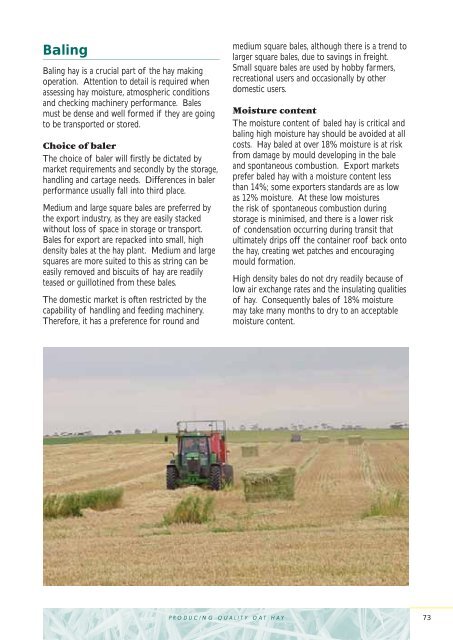You also want an ePaper? Increase the reach of your titles
YUMPU automatically turns print PDFs into web optimized ePapers that Google loves.
Baling<br />
Baling hay is a crucial part of the hay making<br />
operation. Attention to detail is required when<br />
assessing hay moisture, atmospheric conditions<br />
and checking machinery performance. Bales<br />
must be dense and well formed if they are going<br />
to be transported or stored.<br />
Choice of baler<br />
The choice of baler will firstly be dictated by<br />
market requirements and secondly by the storage,<br />
handling and cartage needs. Differences in baler<br />
performance usually fall into third place.<br />
Medium and large square bales are preferred by<br />
the export industry, as they are easily stacked<br />
without loss of space in storage or transport.<br />
Bales for export are repacked into small, high<br />
density bales at the hay plant. Medium and large<br />
squares are more suited to this as string can be<br />
easily removed and biscuits of hay are readily<br />
teased or guillotined from these bales.<br />
The domestic market is often restricted by the<br />
capability of handling and feeding machinery.<br />
Therefore, it has a preference for round and<br />
PRODUCING QUALITY OAT HAY<br />
medium square bales, although there is a trend to<br />
larger square bales, due to savings in freight.<br />
Small square bales are used by hobby farmers,<br />
recreational users and occasionally by other<br />
domestic users.<br />
Moisture content<br />
The moisture content of baled hay is critical and<br />
baling high moisture hay should be avoided at all<br />
costs. <strong>Hay</strong> baled at over 18% moisture is at risk<br />
from damage by mould developing in the bale<br />
and spontaneous combustion. Export markets<br />
prefer baled hay with a moisture content less<br />
than 14%; some exporters standards are as low<br />
as 12% moisture. At these low moistures<br />
the risk of spontaneous combustion during<br />
storage is minimised, and there is a lower risk<br />
of condensation occurring during transit that<br />
ultimately drips off the container roof back onto<br />
the hay, creating wet patches and encouraging<br />
mould formation.<br />
High density bales do not dry readily because of<br />
low air exchange rates and the insulating qualities<br />
of hay. Consequently bales of 18% moisture<br />
may take many months to dry to an acceptable<br />
moisture content.<br />
73

















